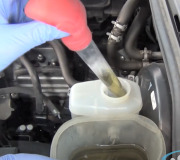Let me back up. After replacing the first brake (left rear), I took the car for a test drive and the brakes seemed just fine. They were nice and hard and felt how they should.
Then when I replaced the rear right, I did the same exact method (except for the wheel cylinder, because it had a rounded bolt), bleeding that cylinder after replacing the brake components . This time, I somehow got air in my system, and bled all four brakes until I had no bubbles in this sequence: rr, rl, fr, fl. They seemed to be nice and tight, so I was going to take the car on a test drive, and as soon as I started the car, the pedal had so much play, I could hit the floor with it, although the stopping and holding seemed to work fine--and still does.
After taking the right brake apart again and checking for possible errors (this was my first drum brake job), I went ahead and bled that wheel cylinder again because I replaced it this time, after hours of getting the dumb rounded bolt off. My brake pedal became tight again. I thought I had it, but I got the same result when I got ready for another test drive.
I'm wondering what the cause of this might be? Would you recommend going to each bleeder valve again and bleeding that way?
Additionally: The reason I decided to replace the drum brakes in the first place is because I kept hearing a tapping noise while pressing down on the brakes at lower speeds (30-5mph). It sounded like once per revolution. I took the car to work this morning and it is still making that noise. Not sure what to do about it, and help would be appreciated. I'm a little hard of hearing, but it sounds to me like it's coming from the back right side of the car.
Monday, March 20th, 2017 AT 1:14 PM


